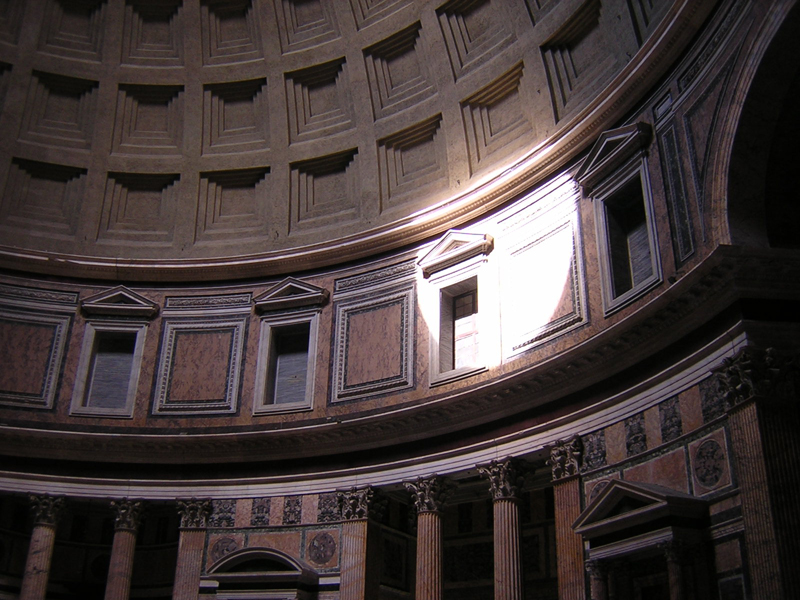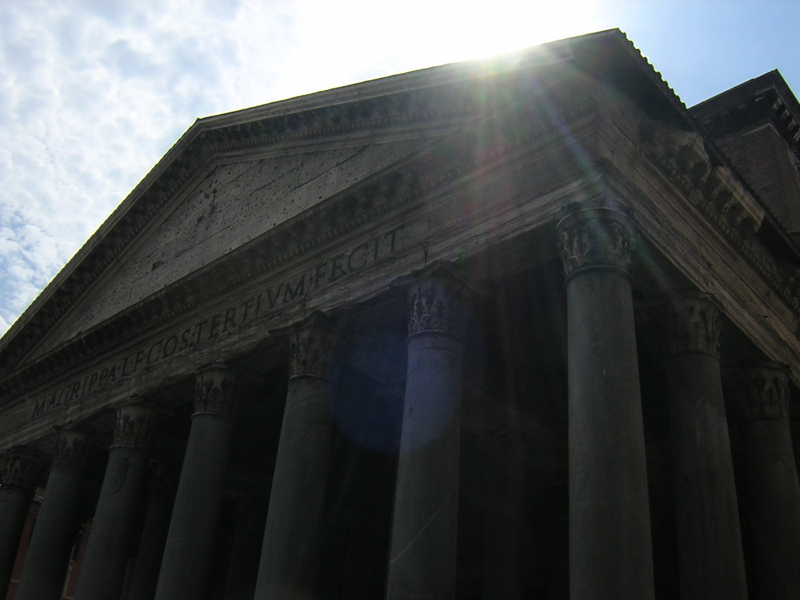|
|
 |
|
Morning in the Pantheon |
|
written
by leahs2 / 10.24.2005 |
|
|
| |
Part 1: |
| |
| |

|
| Photographed on-site. |
| Oculus at midday. |
|
| |
|
| |

|
| Photographed on-site. |
| Exterior at midday. |
|
| |
|
The first visit at midday:
At midday tourists fill every inch of the domed floor; they jostle about and aim their camera to get the best shot of the decorative church. I search to find someone sitting still and looking but I see cameras everywhere. In a space this grand photographs could perhaps serve to trigger a memory of the experience of the space but could never count as a competent representation. The paintings added by the church feel tacky and outmoded in such a majestic building; I wish to see the interior in its original bare form. Noise was everywhere: a jabbering audio track from tourists and a glitzy performed visual from the modern decorations. The flash of cameras seemed to insult the interior space.
I stand against the wall and take a deep breath. Opening my eyes, I take in the peaceful, proud, powerful, solid building that whispers an ancient wisdom. Like a great mother tree in the Pacific Northwest, the mother building lays my troubles aside and encloses and supports my whole being. The light is harshest at this time, coming in through the oculus to spotlight a section of the interior wall. My eyes are directed with the light and as the light moves a story slowly unfolds. I no longer must decide what to do with myself in this massive building. Instead I let myself over for the Pantheon to direct me. Support me, tell me where to look, where to stand, what to see, what to feel this time. I give over my senses to the building and allow the building’s experience to become mine: beauty, serenity, and majesty.
The second visit at closing:
I arrived in the evening light out of breath: I have just run from my apartment in Trastevere to the Pantheon with the hope of catching the Pantheon in the rain. Alas, I have missed the rain by five minutes. But the glassy pool of water on the floor is evidence that rain did indeed enter the building. The pool of water is roped off, as if a wild beast that must be kept separate from the visitors. Electric artificial light illuminates the dome and niches, taking away the potential beauty of the natural light; I am disappointed that I can’t find the light of the oculus. We are herded out the door at closing time, two huge touring groups and stragglers such as me. They try to tame the Pantheon, rope it off, close it up, but the integrity of the original will flash its teeth, in the rain, or in the darkness.
The third visit at opening:
I came upon the Pantheon doors as they were being pushed open by two large men. In Italian, I asked if they were open, and they responded in the affirmative. I was the first visitor to enter the space this morning. I walked in dizzy with the vast, empty, grand space of the dome. And even though my right calf muscle was cramping from the quick walk over on uneven cobblestones, I kept walking. I circled the outer edge of the dome and spiraled in and still kept walking. I looked up to the walls of the dome and let the direction of the coffers move me. The oculus light was directed near the opening, and I watched as it slowly made its way down the inside of the dome. I kept walking, circling, transversing the grand space; I was calm. Who knows how long I would have walked if I had not had to leave for Italian class.
|
| |
|
| |
|
| |
Part 2: |
| |
The vast interior space of the dome and the specificity of the oculus spotlight directs the movement of my eye and body in the building. The ceiling coffers are uneven in size and spacing, they get smaller and angle up to the center. This creates the optical illusion that I am continuously moving toward the oculus, even though I think I am still; I am continually carried towards the circular light, the heaven of the ancient Roman’s. The light coming in through the oculus tells a novel story on the inner walls of the vast dome, directing and defining me within the space.
The exterior space of Piazza Navona is broad. The piazza is outlined by cobblestone and the central focus is the grand white sculptured fountain in the middle. The space is open to the outside air and I am allowed free range to travel the outer rim of the piazza or weave around the inner fountains. Compared to the enclosed and directed focus of the Pantheon, Piazza Navona is open and flexible while remaining enscribed. I can enter, exit and transverse the space in any variety of ways.
The boundaries of Piazza di Sant’Ignazio are left blurrily unclear. The space itself is something of a half circle, yet entrances and exits can take a rounded or linear path to or from the piazza. It is fluidly inscribed; the space is held by buildings yet the space translucently engages me in a specific pathway. I am moved without realizing it as I watch other travelers swirl into and out of the space. Even with its blurry boundaries, Piazza di Sant’Ignazio directs the visitor through the space. On the other hand, Piazza Navona’s unambiguous edges allow the visitor to choose his/her own path through the center.
|
| |
|
| |
|
|
 |
|


